Shattering Foundations: The Catastrophic Decline of U.S. Infrastructure Under Climate Assault

U.S. infrastructure, historically regarded as the backbone of economic stability and national security, is rapidly deteriorating, revealing alarming vulnerabilities in the face of escalating climate change. This decline, while often downplayed by political rhetoric, poses a genuine threat to everyday life, economic resilience, and national sovereignty. From flooded airports to melting bridges, the evidence underscores that the United States has failed to adapt its aging infrastructure to the realities of a warming planet. The current state is far from acceptable; it borders on systemic failure, threatening to incapacitate the very framework that sustains a modern society.
The latest reports by the American Society of Civil Engineers (ASCE) paint a sobering picture: the overall infrastructure receives a meager “C” grade, reflecting decades of neglect and underinvestment. But the core concern is not merely the weak grade—it’s the trajectory. Climate change has introduced unpredictable extremes—unprecedented rainfall, scorching temperatures, violent storms—that existing infrastructure was never designed to withstand. This mismatch is causing catastrophic events such as flooded runways at Fort Lauderdale airport and bridges rendered inoperative by thermal expansion in New York City, exposing an infrastructure unable to cope with today’s climatic extremes.
The Unseen Costs of Old and Inadequate Design
A significant problem lies in the age of most American infrastructure. Much of it was constructed in a bygone era, with engineers planning for a climate that no longer exists. Roads, bridges, airports, and power grids were built under assumptions that are increasingly out of step with current and future conditions. The consequences are grave: a growing percentage of key infrastructure is at risk from natural disasters intensified by climate change. According to risk analytics from firms like First Street, nearly one-fifth of power infrastructure faces major threats from floods and wildfires, while bridges and airports are not far behind.
This systemic neglect undermines not only safety but also economic stability. Investors are becoming acutely aware of these risks, prompting a shift in how they evaluate infrastructure projects. Climate resilience is no longer optional; it is a financial imperative. Institutions like JPMorgan Chase are integrating climate risk into their investment strategies, signaling a fundamental shift in the financial sector’s view of infrastructure assets. Yet, the challenge remains: funding these overdue repairs and upgrades is daunting.
Science Under Siege: A Threat to Resilience
Understanding and addressing climate-induced vulnerabilities requires solid scientific data—data that has faced political attacks and deep cuts over recent years. Federal agencies responsible for climate science, such as NOAA and FEMA, have suffered reductions that threaten to weaken the foundation upon which resilient infrastructure planning depends. This scientific marginalization hampers efforts to predict, prepare for, and mitigate the worst effects of climate change.
As climate science suffers politically motivated dismissals and budget cuts, the risk increases that every investment decision, from infrastructure design to insurance policies, will be based on outdated or incomplete information. The consequences could be devastating: buildings and transportation networks misaligned with future conditions, increased costs from unmanaged risks, and an erosion of public trust in government capabilities.
Failure to Invest: The Cost of Inaction
Crucially, addressing these vulnerabilities requires substantial financial investment—a figure the nation has long avoided. The ASCE estimates a staggering $3.7 trillion over the next decade is needed just to bring U.S. infrastructure to a state of reliable operation. However, political will remains elusive. The Trump administration’s withdrawal from resilience initiatives, such as cancelling nearly $1 billion allocated for disaster mitigation, exemplifies the shortsightedness that plagues infrastructure policy.
Without significant government commitment, combined with private sector involvement, the nation risks a cycle of neglect that will only deepen. The chasm between infrastructure needs and available funding continues to widen, with taxpayers and future generations footing the bill for past recklessness. This isn’t just about fixing potholes or replacing old bridges; it’s about safeguarding the economic and social fabric of a nation facing an increasingly volatile climate.
The Stark Reality of a Neglected Future
In this climate of neglect and shortsightedness, the United States finds itself on the brink of a crisis, with its infrastructure vulnerable, outdated, and underfunded. The question is no longer whether extreme weather will worsen but whether policymakers are willing to confront the reality that our current approach—marked by delay, underinvestment, and political disinterest—is a death sentence for sturdy infrastructure. Unless a shift toward prioritizing resilience and scientific integrity occurs, the consequences will be devastating—a nation ill-prepared for the storms, heatwaves, and flooding that are becoming the new normal.





